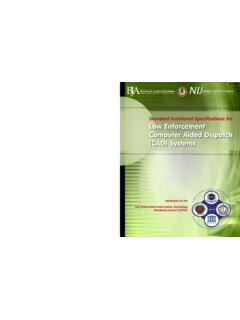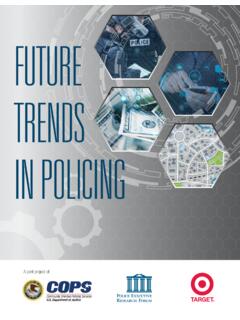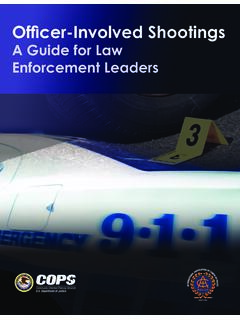Transcription of Body-Worn Camera Frequently Asked Questions
1 Body-Worn Camera Frequently Asked Questions 1. What are officer Body-Worn cameras? Officer Body-Worn cameras (BWCs) are relatively small devices that record interactions between community members ( , the public, suspects, and victims) and law enforcement officers. The video and audio recordings from BWCs can be used by law enforcement to demonstrate transparency to their communities; to document statements, observations, behaviors, and other evidence; and to deter unprofessional, illegal, and inappropriate behaviors by both law enforcement and the public. 2. How does an officer Body-Worn Camera work? The technology consists of the Camera , which is typically worn on the officer s uniform (placed optionally on the shoulder lapel, sunglasses, or hat), with a forward-facing viewable area.
2 When thinking about the mounting location, an agency should consider the uniform types worn by officers and how uniforms may vary throughout the year (summer, winter). Additional accessories may be required to ensure the Camera is properly positioned, securely attached and protected to support the officer and his or her unique mission. There are a number of different types of Camera with differing options, including user controls such as push to record, touch-screen controls, video and audio feed, and playback in field. The video evidence is uploaded through a docking station on a local storage device ( , server) or through an online web-based digital media storage platform where the evidence can be encrypted and managed. Some models also allow for video upload while in the field.
3 At the February 26-27, 2015 Bureau of Justice Assistance Body-Worn Camera Expert Panel convening, Donna Twyford of the Customs and Border Protection Service shared a warning that cameras with lots of options are not always beneficial they may simply just present more items that can be lost or broken. During those same discussions, Maggie Goodrich of the Los Angeles Police Department (LAPD) explained it is important to critically look at and transparently share equipment capabilities. In the LAPD, there was an officer evaluation if the vendor said that the Camera did A, B, and C, we tested it to prove it. We conducted reviews of different mounts and presented the videos to evaluate quality. It was a fully transparent process; we felt responsible to demonstrate and share with groups when video did not fully capture or represent the entire event.
4 3. How are Body-Worn cameras different from dashboard cameras and CCTV systems? Dashboard cameras are fixed to the law enforcement vehicles, therefore only capturing video from the front of the vehicle. Some dashboard cameras allow for audio recording near the law enforcement vehicle. 2015 1 Body-Worn Camera Frequently Asked Questions worn cameras (BWCs) retain the strengths of the dashboard Camera , but they allow the technology to accompany the officer wherever he or she goes. In some instances, using BWCs and dashboard cameras together can be beneficial, documenting an event from two different perspectives. BWCs are different from close-circuit television systems (CCTV). CCTVs are stationary systems that record behavior in a given public space. Sir Bernard Hogan-Howe of the London Metropolitan Police Service highlights the core differences between BWCs and CCTVs: In London we have CCTVs, which are quite extensive and becoming even more so, but the distinction is that those cameras don t listen to your conversations.
5 They observe behavior and see what people do and cover public space, so you can see if there is a crime being committed. But CCTVs don t generally seek out individuals (PERF, 2014: 11). For additional information, see Police Executive Research Forum (PERF), Implementing a Body-Worn Camera Program: Recommendations and Lessons Learned: 4. How many law enforcement agencies have adopted officer worn-body cameras? Currently, we do not have an accurate estimate of the number of law enforcement agencies that have initiated Body-Worn Camera (BWC) programs. Several law enforcement agencies in the United Kingdom were experimenting with BWCs as far back as 2005. In August 2013, the Police Executive Research Forum (PERF) surveyed 500 law enforcement agencies regarding their use of BWCs.
6 Of the 254 agencies that responded, just 25% (n=63) indicated that they deployed BWCs. Interest in the technology has grown tremendously since then. One BWC vendor advertised in February 2015 that its product has been purchased by 4,000 law enforcement agencies worldwide, but this figure has not been verified. One expert has estimated that between 4,000 and 6,000 law enforcement agencies are planning to adopt or have already adopted BWCs. The Bureau of Justice Statistics (BJS) is performing a survey to better understand the number of law enforcement agencies that have implemented a BWC program. For additional information, see: Police Executive Research Forum (PERF) for community oriented policing services , Implementing a Body-Worn Camera Program: Recommendations and Lessons Learned: Bureau of Justice Statistics, Law Enforcement Management and Administrative Statistics (LEMAS), #Related_topics 2015 2 Body-Worn Camera Frequently Asked Questions 5.
7 What are the best available sources of information on officer Body-Worn cameras? There are a handful of useful resources on Body-Worn cameras (BWCs). The Police Executive Research Forum (PERF) and the community oriented policing services (COPS) Office published a report in 2014 that examines key issues and offers policy recommendations. The report is based on survey responses from 254 agencies, interviews with 40 law enforcement executives who have implemented BWCs, and a one-day conference held on September 11, 2013 with more than 200 law enforcement executives, scholars, and experts. In April 2014, the Office of Justice Programs Diagnostic Center published a report that describes the core issues surrounding the technology and examines the state of research on those issues (White, 2014).
8 In March 2014, the National Institute of Justice (NIJ) published a market survey that compared BWC vendors across a range of categories. There is also a growing number of published evaluations that examine the implementation, impact, and consequences of Body-Worn cameras. This web site and toolkit is intended to be a clearinghouse of the latest available research, reports, and knowledge on the technology. For additional information, see: National Law Enforcement and Corrections Technology Center (NLECTC) for the National Institute of Justice, Primer on Body-Worn Cameras for Law Enforcement: Office of Justice Programs Diagnostic Center, Police Officer Body-Worn Cameras: Assessing the Evidence: System Assessment and Validation for Emergency Responders (SAVER) for the Science and Technology Directorate, Body-Worn Video Cameras for Law Enforcement Assessment Report: National Law Enforcement and Corrections Technology (NLECTC) for the National Institute of Justice, Body-Worn Cameras for Criminal Justice: Market Survey: Police Executive Research Forum (PERF) for community oriented policing services , Implementing a Body-Worn Camera Program: Recommendations and Lessons Learned.
9 Police and Crime Standards Directorate, Guidance for the Police Use of Body-Worn Video Devices: 2015 3 Body-Worn Camera Frequently Asked Questions Privacy Commissioner of Canada, Canada s Guidance for the Use of Body-Worn Cameras by Law Enforcement Authorities: For additional evaluations from around the United States, United Kingdom, and Canada, see: Phoenix, Arizona: Rialto, California: Mesa, Arizona: of Wight, : Essex, : Paisley & Aberdeen, : Plymouth, : Edmonton, Canada: Los Angeles Police Department & Las Vegas Metro Police Department: #ongoing Or view BWC Toolkit Research Resources with the category of Implementation Experiences 6. How can law enforcement agencies benefit from Body-Worn Camera program?
10 Body-Worn cameras (BWCs) are only one of the tools available to law enforcement for improving community trust, transparency, and accountability. There are several benefits for law enforcement officers who wear BWCs. BWCs provide an additional layer of safety for the officer. Adoption of a BWC program can represent a law enforcement department s effort to demonstrate transparency and accountability. In several studies, community member complaints against officers decreased following adoption of BWCs (Katz et al., 2015; Ariel, Farrar, & Sutherland, 2014; Mesa Police Department, 2013). The results from these studies are 2015 4 Body-Worn Camera Frequently Asked Questions supported by in-person interviews with 40 law enforcement executives conducted by the Police Executive Research Forum (PERF).














